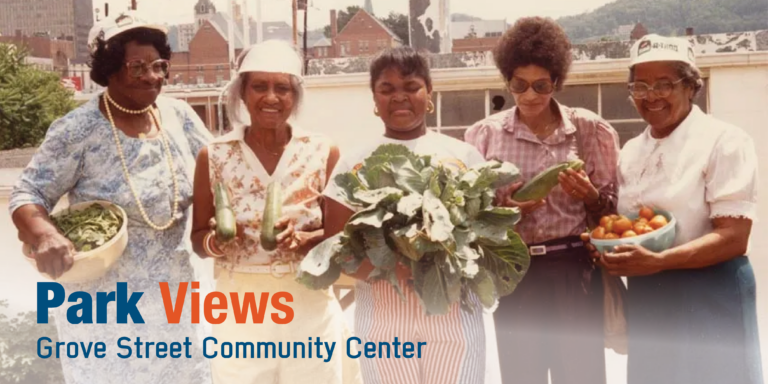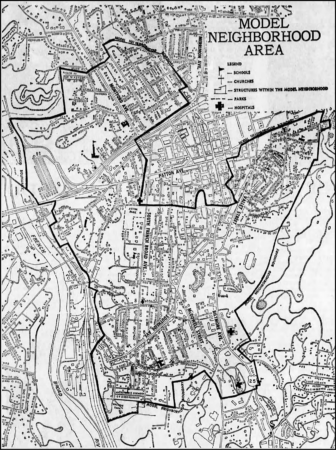This entry is part of Park Views, an Asheville Parks & Recreation series that explores the history of the city’s public parks and community centers – and the mountain spirit that helped make them the unique spaces they are today. Read more from the series.
Senior Opportunity Center opened in the 1970s as a resource center specializing in recreational programming and outreach services for older adults, channeling skills, talents, and curiosity from community members in the prime of life. Now known as Grove Street Community Center, it remains a focal point for active older residents to stay healthy and independent, but offers much more.
Model Cities
Harvest House Community Center opened in 1964 as one of North Carolina’s first senior centers. Though local community organizations and government agencies operated programs for older adults, Harvest House was the first central location for social, cultural, and recreational services for the age group. These programs were expanded to other Asheville Parks & Recreation (APR) community centers throughout the city on a smaller scale as part of a “mini senior centers” initiative.
Within a few years, it became apparent that Asheville’s older residents needed another dedicated community center. At the time, funding was available from several federal programs aimed at reducing poverty through education and economic opportunities, health care access, and improving living conditions. Legislation establishing the Model Cities program was passed in 1966 with Asheville selected as one of the sites.
Model Cities locations acted as case studies to develop new antipoverty initiatives and alternative forms of municipal government. The program represented a new approach that emphasized social programs in addition to “urban renewal,” and sought to coordinate the actions of numerous government agencies in a multifaceted attack on the complex roots of urban poverty. Initial goals emphasized comprehensive planning, involving not just rebuilding but also rehabilitation, social service delivery, and participation from those living in low-income neighborhoods.
Asheville’s Model Cities Commission initially consisted of six members appointed by City Council and six elected directly by residents in the city’s Model Neighborhoods of East End/Valley Street, Southside, Hill Street, Stumptown, and parts of Montford. The first year budget of $4.2 million funded a number of educational and recreational programs for kids, teens, and older adults, as well as employment training, health programs, and civic engagement.
In 1970, more than 1 in 5 people living in the East End/Valley Street area were over 60 years of age. Stephens-Lee Community Center (then known as Hill Top Community Center) began a part-time program for seniors in the mid-1960s, but struggled to expand the service to meet the neighborhood’s need due to funding challenges. Model Cities’ Annie Glenn and Nola Knuckles proposed a partnership with APR to open a full-time community center designed specifically to meet the needs of older persons residing in low to moderate income areas.
Senior Scene
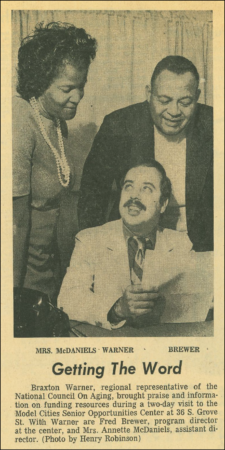 Senior Opportunity Center opened during the summer of 1971 in a building formerly occupied by the Employment Security Commission. The commission had constructed the building in 1959, then relocated next door to 48 Grove Street at the end of 1970.
Senior Opportunity Center opened during the summer of 1971 in a building formerly occupied by the Employment Security Commission. The commission had constructed the building in 1959, then relocated next door to 48 Grove Street at the end of 1970.
Recognizing older adults brought significant value to to the community and challenging then-prevalent perceptions that aging be associated with declining health, dependency, and irrelevance, Senior Opportunity Center had a lounge area with television and radio, snack bar, piano, craft room, game tables, and spaces for counseling in wellness matters, employment and volunteer opportunities, and Social Security. Special events during its first weeks included covered dish luncheons, film screenings, lectures, exhibits, parties, and musicals. The center’s van service provided daily transportation and made monthly road trips to nearby destinations such as Cherokee and Six Flags Over Georgia.
Within a year, over 2,500 monthly visitors were served by programs including crafts, music, games (cards, pool, bingo, and more), inspirational hour, continuing education through AB Tech, liquid embroidery, ceramics and pottery, home visits, social clubs, and free bus tickets for Model Neighborhood residents. The center’s kitchen provided around 100 lunchtime meals on site and another 60 delivered by Meals on Wheels. A 1973 request to expand the kitchen with commercial-grade equipment highlighted the need to serve an additional 300 homebound residents on a waiting list.
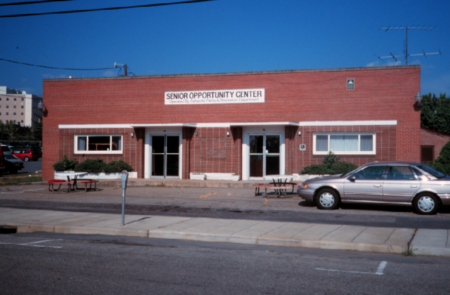 The building, which had been leased for $750 a month, was purchased by the City of Asheville in 1974 with Housing and Urban Development (HUD) funds. When Model Cities was shut down in 1975, the bulk of its remaining money was earmarked for Senior Opportunity Center. For the remainder of the decade, the center was largely funded by HUD’s Community Development Block Grant Program.
The building, which had been leased for $750 a month, was purchased by the City of Asheville in 1974 with Housing and Urban Development (HUD) funds. When Model Cities was shut down in 1975, the bulk of its remaining money was earmarked for Senior Opportunity Center. For the remainder of the decade, the center was largely funded by HUD’s Community Development Block Grant Program.
Aging in the ‘80s and ‘90s
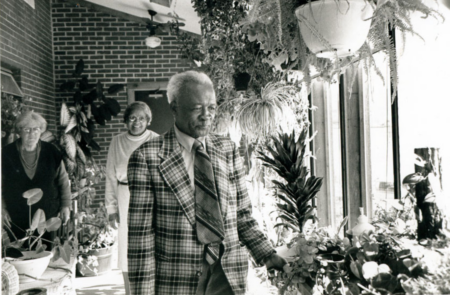 More than a building, Senior Opportunity Center led to successful partnerships with other community organizations to provide comprehensive, well-rounded opportunities to the large number of older residents in the area. Many of the organizations wrote letters in support of a grant for major renovations at Harvest House in 1978. Senior Opportunity Center received enhancements of its own in 1979 with construction of a ramp and widening of the entrance door for wheelchair access, addition of handicap parking spaces, renovation of restrooms to include accessible stalls, and installation of braille labels on all doors.
More than a building, Senior Opportunity Center led to successful partnerships with other community organizations to provide comprehensive, well-rounded opportunities to the large number of older residents in the area. Many of the organizations wrote letters in support of a grant for major renovations at Harvest House in 1978. Senior Opportunity Center received enhancements of its own in 1979 with construction of a ramp and widening of the entrance door for wheelchair access, addition of handicap parking spaces, renovation of restrooms to include accessible stalls, and installation of braille labels on all doors.
As the center’s regulars redefined aging in the 1980s, aerobics, softball, and other fitness programs joined diabetes education, a community garden, computer classes, tax assistance, and annual events like the Miss Senior Pageant, Holiday Bazaar, and Thanksgiving for Seniors. It was also a popular stop for state and local elected leaders to engage with constituents.
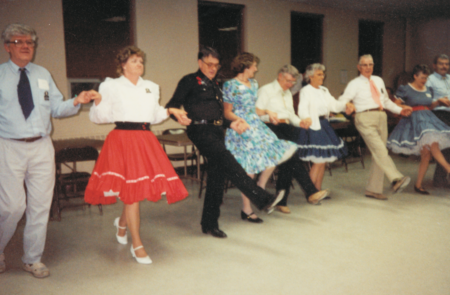 Through the 1990s, regular renovations and additions included a performance stage, commercial kitchen, expanded craft room, ceramic kiln, greenhouse, drop-off driveway, new restrooms, awnings and exterior enhancements, and outdoor picnic seating. As government agencies centralized their aid programs, Senior Opportunity Center primarily focused on recreational, cultural, social, educational, and nutritional services as a multipurpose community center.
Through the 1990s, regular renovations and additions included a performance stage, commercial kitchen, expanded craft room, ceramic kiln, greenhouse, drop-off driveway, new restrooms, awnings and exterior enhancements, and outdoor picnic seating. As government agencies centralized their aid programs, Senior Opportunity Center primarily focused on recreational, cultural, social, educational, and nutritional services as a multipurpose community center.
During the Great Recession, Senior Opportunity Center programming was moved to West Asheville Community Center for a short time as both served similar populations. However, the Asheville-Buncombe Human Relations Council convinced Asheville Parks & Recreation to move all of the programs back to the center on Grove Street where they have remained.
Times Change
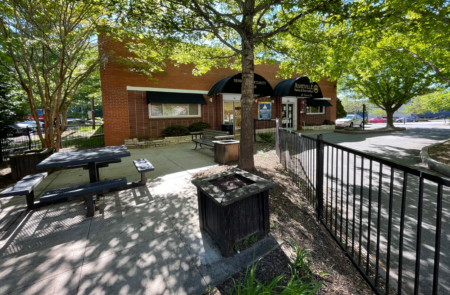 As the center on Grove Street has evolved over time, so has the way the community talks about older adults and retirees. As people live longer and more actively, it’s unsurprising that “senior opportunity center” implied a place for the “old” or “elderly,” not a resource for those still exploring new interests and making new friends. As 50+ or 65+ became more arbitrary distinctions, the name of the center no longer fit the modern-day experience of aging.
As the center on Grove Street has evolved over time, so has the way the community talks about older adults and retirees. As people live longer and more actively, it’s unsurprising that “senior opportunity center” implied a place for the “old” or “elderly,” not a resource for those still exploring new interests and making new friends. As 50+ or 65+ became more arbitrary distinctions, the name of the center no longer fit the modern-day experience of aging.
In 2022, Asheville City Council unanimously approved a request to rename the building to Grove Street Community Center. While the community center retains a focus on older adults, the new name reflects its expanded programming for all ages. As the only public community center in the central business district, the location is the most accessible for nearby neighborhoods including Downtown, South French Broad, South Slope, and WECAN.
Do you have photos or stories to share about Grove Street Community Center? Please send them to cbubenik@ashevillenc.gov so APR can be inspired by the past as we plan our future. Sign up for APR’s monthly newsletter and follow APR on Facebook and Instagram for additional photos, upcoming events, and opportunities.
Photo and Image Credits
- In 20th century Asheville, like-minded people often met at homes, offices, and community centers to discuss solutions to community needs. MAGIC (Mountain Area Gardeners in Communities) began in 1983 focused on planting community gardens on vacant lots allowing apartment dwellers and other families without room from a garden to grow their own fruits, vegetables, and flowers. Bernice Williams, an unknown woman, another unknown woman who doesn’t appear to be a fan of her bounty, Lue Willie Young, and Corine Witherspoon (left to right) show off their harvest in a parking lot next to the community center on Grove Street in 1988. Courtesy of Buncombe County Special Collections, Pack Memorial Public Library, Asheville, North Carolina.
- Mayor Richard Wood championed several projects as part of the Model Cities antipoverty program. Asheville Parks & Recreation partnered with Model Cities leaders on projects including Grove Street Community Center, Montford Recreation Complex and Riverside Park (now collectively Tempie Avery Montford Community Center), and Livingston Street Neighborhood Center (which became the W.C. Reid Center and now Arthur R. Edington Education and Career Center). The ambitious federal urban aid program succeeded in fostering a new generation of mostly Black leaders. Model Cities and the Older Americans Act of 1965, among others, were part of President Lyndon Johnson’s Great Society reforms. The Nixon administration officially changed course in 1969; however in the majority of cities, citizen participation mechanisms continued to play an important role in local decision-making. Asheville’s Model Cities “action years” were 1971-1974.
- With Harvest House and Senior Opportunity Center, Asheville was a leader in establishing free and low-cost recreational and cultural programs for older residents. A visit from Braxton Warner of National Council on Aging in 1973 opened the door for more funding sources. He’s seen here with Annette McDaniels and Fred Brewer, the center’s assistant director and program director, respectively.
- The space inside the walls of the center buzzed with activity, but the outside still had plenty of opportunities for improvement for most of the center’s first 30 years. In this picture from the 1990s, a picnic table almost seems like an afterthought.
- Asheville Parks & Recreation added a 14-by-48 foot glass greenhouse in 1987 to extend year-round programming and boost heat in the building during winter months. While its primary function was to provide an area to grow plants, community members quickly began using it to play cards and table games or eat lunch surrounded by sunshine. Photo by Peggy Gardner. Courtesy of Buncombe County Special Collections, Pack Memorial Public Library, Asheville, North Carolina.
- Square dancing is one of Grove Street Community Center’s longest running programs. Under the guise of The Downtown Dancers, square, line, and contra dances have been regularly scheduled since the 1970s.
- After 50 years, Senior Opportunity Center became Grove Street Community Center in 2022 to better reflect its purpose to serve older adults and the entire community, particularly those who live in or near downtown Asheville.
